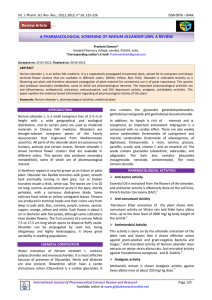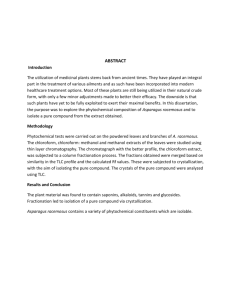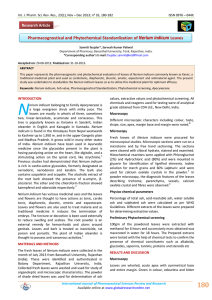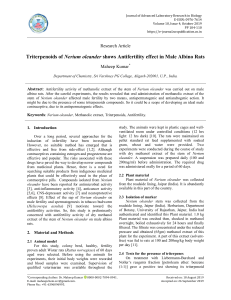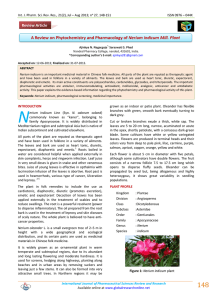Document 13308755
advertisement
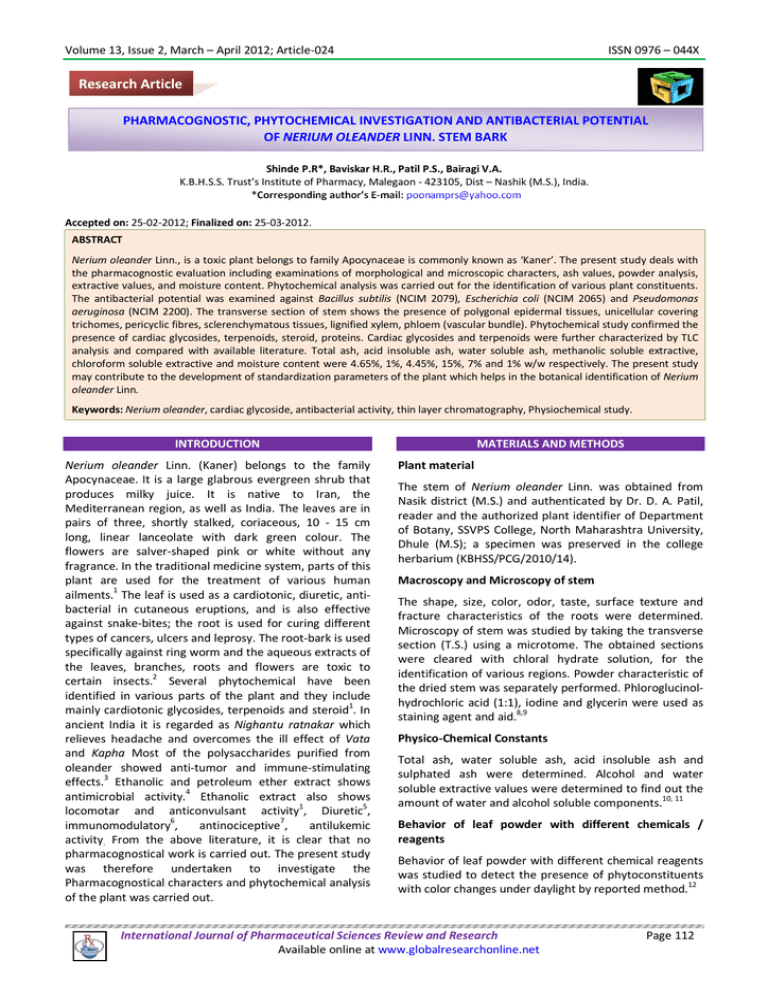
Volume 13, Issue 2, March – April 2012; Article-024 ISSN 0976 – 044X Research Article PHARMACOGNOSTIC, PHYTOCHEMICAL INVESTIGATION AND ANTIBACTERIAL POTENTIAL OF NERIUM OLEANDER LINN. STEM BARK Shinde P.R*, Baviskar H.R., Patil P.S., Bairagi V.A. K.B.H.S.S. Trust’s Institute of Pharmacy, Malegaon - 423105, Dist – Nashik (M.S.), India. Accepted on: 25-02-2012; Finalized on: 25-03-2012. ABSTRACT Nerium oleander Linn., is a toxic plant belongs to family Apocynaceae is commonly known as ‘Kaner’. The present study deals with the pharmacognostic evaluation including examinations of morphological and microscopic characters, ash values, powder analysis, extractive values, and moisture content. Phytochemical analysis was carried out for the identification of various plant constituents. The antibacterial potential was examined against Bacillus subtilis (NCIM 2079), Escherichia coli (NCIM 2065) and Pseudomonas aeruginosa (NCIM 2200). The transverse section of stem shows the presence of polygonal epidermal tissues, unicellular covering trichomes, pericyclic fibres, sclerenchymatous tissues, lignified xylem, phloem (vascular bundle). Phytochemical study confirmed the presence of cardiac glycosides, terpenoids, steroid, proteins. Cardiac glycosides and terpenoids were further characterized by TLC analysis and compared with available literature. Total ash, acid insoluble ash, water soluble ash, methanolic soluble extractive, chloroform soluble extractive and moisture content were 4.65%, 1%, 4.45%, 15%, 7% and 1% w/w respectively. The present study may contribute to the development of standardization parameters of the plant which helps in the botanical identification of Nerium oleander Linn. Keywords: Nerium oleander, cardiac glycoside, antibacterial activity, thin layer chromatography, Physiochemical study. INTRODUCTION Nerium oleander Linn. (Kaner) belongs to the family Apocynaceae. It is a large glabrous evergreen shrub that produces milky juice. It is native to Iran, the Mediterranean region, as well as India. The leaves are in pairs of three, shortly stalked, coriaceous, 10 - 15 cm long, linear lanceolate with dark green colour. The flowers are salver-shaped pink or white without any fragrance. In the traditional medicine system, parts of this plant are used for the treatment of various human ailments.1 The leaf is used as a cardiotonic, diuretic, antibacterial in cutaneous eruptions, and is also effective against snake-bites; the root is used for curing different types of cancers, ulcers and leprosy. The root-bark is used specifically against ring worm and the aqueous extracts of the leaves, branches, roots and flowers are toxic to certain insects.2 Several phytochemical have been identified in various parts of the plant and they include 1 mainly cardiotonic glycosides, terpenoids and steroid . In ancient India it is regarded as Nighantu ratnakar which relieves headache and overcomes the ill effect of Vata and Kapha Most of the polysaccharides purified from oleander showed anti-tumor and immune-stimulating effects.3 Ethanolic and petroleum ether extract shows antimicrobial activity.4 Ethanolic extract also shows locomotar and anticonvulsant activity1, Diuretic5, immunomodulatory6, antinociceptive7, antilukemic activity. From the above literature, it is clear that no pharmacognostical work is carried out. The present study was therefore undertaken to investigate the Pharmacognostical characters and phytochemical analysis of the plant was carried out. MATERIALS AND METHODS Plant material The stem of Nerium oleander Linn. was obtained from Nasik district (M.S.) and authenticated by Dr. D. A. Patil, reader and the authorized plant identifier of Department of Botany, SSVPS College, North Maharashtra University, Dhule (M.S); a specimen was preserved in the college herbarium (KBHSS/PCG/2010/14). Macroscopy and Microscopy of stem The shape, size, color, odor, taste, surface texture and fracture characteristics of the roots were determined. Microscopy of stem was studied by taking the transverse section (T.S.) using a microtome. The obtained sections were cleared with chloral hydrate solution, for the identification of various regions. Powder characteristic of the dried stem was separately performed. Phloroglucinolhydrochloric acid (1:1), iodine and glycerin were used as staining agent and aid.8,9 Physico-Chemical Constants Total ash, water soluble ash, acid insoluble ash and sulphated ash were determined. Alcohol and water soluble extractive values were determined to find out the 10, 11 amount of water and alcohol soluble components. Behavior of leaf powder with different chemicals / reagents Behavior of leaf powder with different chemical reagents was studied to detect the presence of phytoconstituents with color changes under daylight by reported method.12 International Journal of Pharmaceutical Sciences Review and Research Available online at www.globalresearchonline.net Page 112 Volume 13, Issue 2, March – April 2012; Article-024 Extraction of plant material The Stem of the plant was dried in natural sunlight for 7 days. The dried, pulverized stem powder was treated with methanol and chloroform by using hot percolation method to obtain methanolic and chloroform extract respectively. The extracts were evaporated to dryness under reduced pressure at 45°C to give solid residue. The residue was weighed and stored in refrigerator for further phytochemical study.13 ISSN 0976 – 044X minutes. In aseptic room the medium was poured into sterile petri dishes to uniform depth and then allowed to cool at room temperature. The inoculums of test organisms were spread on Nutrient agar plates. Wells of 6 mm were punched into the agar medium and filled with test solution and compared with control. The plates were incubated for 48 hours at 37°C. The antibacterial activity was evaluated by measuring the zone of inhibition against test organism. RESULTS AND DISCUSSION Phytochemical Screening The chloroform extract and methanol extracts were screened for the presence of its constituents by utilizing 14 standard methods of analyses. Thin layer chromatography For the TLC fingerprint the chloroform extract and methanolic extract were subjected to thin layer chromatographic analysis, to find the presence of number of chemical constituents to support the chemical test. Analytical TLC plates were prepared by pouring the silica gel G slurry on the glass plates. Drying the thin layer plates, for 30 minutes in air and then in an oven at 110°C for another 30 minutes. For qualitative work, spot was applied in a row along one side of plate, about 2cm from edge, by using capillary tubes. The range of sample volume was controlled, spreading not more than 0.5cm.The plate was placed in previously saturated TLC chamber with mobile phase. The Rf values are compared with standard drug and colours are recorded.15, 16 Morphological study Nerium oleander is an evergreen shrub reaching four metres in height. Leaves are 10 to 22 cm long, narrow, untoothed and short-stalked, dark or grey- green in colour. All leaves have a prominent mid rib, are "leathery" in texture and usually arise in groups of three from the stem. Stems are dark green in colour. Microscopical Evaluation The epidermal cell was compactly arranged with intracellular spaces with trichomes. Epidermis made up of single layer polygonal cells with slightly anticlinical walls. Stomata was absent on the both sides of epidermis but unicellular covering trichomes were present on the both side of epidermis. Pericyclic fibers, sclerenchymatous tissue, oil gland also observed. Vascular bundle containing lignified xylem & phloem was present in the stem and cortex containing starch gains (figure 1). Antibacterial activity17-19 Microorganisms The following cultures were used: Bacillus subtilis (NCIM 2079), Escherichia coli (NCIM 2065) and Pseudomonas aeruginosa (NCIM 2200). The cultures are obtained from National Collection of Industrial Microorganism (NCIM) Pune, India. The cultures of these bacteria were grown in nutrient broth at 37°C and maintained nutrient agar slants< 12°C. Chemicals Ciprofloxacin was procured from Ranbaxy research lab., Gurgaon, India. All the chemicals were of analytical grade and used as received. Figure 1: Trasverese section of N. oleander stem shwoing presence different characterisitic tissues; stained with phloroglucinol: HCl (1:1) Preparation of Inoculum Several colonies of a 48 hr culture of Bacillus subtilis, Escherichia coli, Pseudomonas aeruginosa were suspended in sterile saline solution (0.9%). Turbidity was adjusted to an absorbency of 0.18 to 0.25 at 625nm. Well plate method The test solution of methanolic and chloroform extract was prepared at a conc. of 25, 50, 75, 100 mg/ml. Ciprofloxacin was taken as standard for antibacterial activity at a conc. 10 µg/ml. Nutrient agar medium was prepared and sterilized by an autoclaving at 15 psi for 15 Table 1: Histochemical reaction of stem of Nerium oleander Reagents Constituents Colors Aniline SO4 + H2SO4 Lignin Yellow Histological zones Epidermis Phloroglucinol + HCl Lignin Pink Xylem, medullary rays Weak Iodine solution Starch Blue Cortex Millons reagent Proteins White Pith H2SO4 Ca. Oxalate Needles /prismatic Cortex International Journal of Pharmaceutical Sciences Review and Research Available online at www.globalresearchonline.net Page 113 Volume 13, Issue 2, March – April 2012; Article-024 Observation and result pertaining to microchemical tests and behavior of specific reagent towards plant tissue were represented in table 1. In the histochemical analysis the micro chemical tests showed the presence of midrib, vascular bundle and xylem vessels. The powder microscopy shows the fragments of unicellular covering and glandular trichomes, phloem fibers, parenchyma cells, numerous xylem vessels of spiral type and Epidermal cells with anomocytic stomata (figure 2). Figure 2: Powder characteristics of N. oleander stem. Physiochemical study Many physiochemical parameters were evaluated, methanol soluble extractive values was found to be greater than chloroform. Whereas sulphated ash was higher than rest all. Moisture content was nearly 1% (table 2). Behavior of powder drug towards different chemical reagent were present in table 3. ISSN 0976 – 044X Table 2: Physical parameters of Nerium oleander stem Parameters Results (% W/W) Total ash 4.65% Acid insoluble ash 1% Water soluble ash 4.45% Sulphated ash 12.65% Methanol soluble extractive value 15% Chloroform soluble extractive value 6.14% Moisture content 1% Table 3: Fluorescence analysis of stem powder of Nerium oleander Regents Picric acid Conc. H2SO4 Aq. Fecl3 Iodine solution Ammonia Color/ppt Slight ppt. Reddish brown Bluish black ppt Blue No change Spot test Aq. AgNo3 Aq. NaoH Mg – Hcl Aq. Lead acetate Liberman Burchardt’s test Stains observed Precipitation Yellow Magenta White ppt Reddish green Constituents Alkaloids present Steroids/triterpenoids present Tannins present Starch present Anthroquinone glycosides absent Fixed oils present Proteins present Flavonoids present Flavonoids present Tannins present Steroids and tannins are present Phytochemical screening Phytochemical investigation of methanolic and chloroform extract showed presence of terpenoids, tannins, saponins but cardiac glycoside was present in chloroform extract only (table 4). Table 4: Phytochemical screening of stem extract Alternative Test Methanolic extract Chloroform Extract Cardiac Glycoside + + Terpenoids + + Tannins + + Saponins + Steroids + + = present; - = absent Table 5: Thin layer chromatography pattern of stem extracts Sample Chloroform extract Methanolic extract Microorganism B. subtilis E. coli P. aeruginosa Solvent system Ethyl acetate: methanol: Water (100:13:10) petroleum ether: ethyl acetate (10:1) Spraying reagent No. and colour of spot Rf value Anisalehyde-H2SO4 5 (blue, blue, violet, blue, violet) 0.68, 0.71, 0.74, 0.82, 0.88, 0.99 respectively. 6(blue, grey, violet, violet, blue, blue) 6 (grey, grey, violet, blue, orange, violet) 5( Dark blue, blue, blue, faint blue, orange) 0.19, 0.23, 0.44, 0.63, 0.80, 0.94 respectively. 0.23, 0.38, 0.55, 0.59, 0.76, 0.98 respectively. 0.35, 0.41, 0.49, 0.54, 0.61 respectively. Libermann-burched Chloroform (100%) Vanillin- H2SO4 Ethyl acetate: formic acid: Tolune (4.5:0.75:2.5) 1% ferric chloride Table 6: Antimicrobial activity of N. oleander stem extract Zone of inhibition(mm) Cipro (µg/ml) Chloroform extract (mg/ml) Methanolic extract (mg/ml) 10 25 50 75 100 25 50 75 100 24.6±0.6 -5± 0.78 8±0.55 12±0.3 6± 0.0 9.2± 0.0 12.3±0.6 15.5±0.3 22.4±0.3 5± 0.3 7.03± 0.3 9.9±0.6 11.3±0.0 8± 0.3 10.3± 0.3 12.7± 0.6 14.9± 0.6 29.7± 0.3 5± 0.3 7± 0.0 9.2± 0.3 12.3±0.4 5.03±0.3 7.8±0.3 10.4± 0.6 12.9± 0.3 Cipro: ciprofloxacin, values are expressed as Mean± SEM International Journal of Pharmaceutical Sciences Review and Research Available online at www.globalresearchonline.net Page 114 Volume 13, Issue 2, March – April 2012; Article-024 ISSN 0976 – 044X Thin Layer Chromatography REFERENCES 1. Singhal KG, Gupta GD, Some central nervous system activities of Nerium oleander Linn. flower extract, Tropical Journal of Pharmaceutical Research . 10 (4), 2011. 455-461. 2. Vaidyaratnam PS, Varier’s Arya Vaidya Sala -Indian Medicinal Plants. A Compendium of 500 species, Vol. 4, Orient Longman, Chennai, India, 1994; p 126-130. 3. Atiya Z, Siddiqui BS, Sabira B, Siddiqui S, Syria S, Journal of Ethnopharmacology, 49,1995, 33-39. 4. Sabira Begum, Bina S. Siddiqui, Razia Sultana, Atiya Zia and Amin Suria: Bio-active cardenolides from the leaves of Nerium oleander. Phytochemistry, 50, 1999, 435-438. 5. Müller BM, Rosskopf F, Paper DH, Kraus J and Franz G: Polysaccharides from Nerium oleander structure and biological activity. Pharmazie 46(9), 1991, 657-63. 6. Erdemoglu N, Küpeli E and Yeşilada E: Anti-inflammatory and antinociceptive activity assessment of plants used as remedy in Turkish folk medicine. J Ethnopharmacol. 89(1), 2003; 123-9. Figure 3: Showing the TLC pattern, A: chloroform extract after spaying with Anisaldehyde- H2SO4 reagent. B: chloroform extract after spaying with Libermann – burched reagent. C: Methanolic extract spraying with vanillin- H2SO4 reagent., D: methanolic extract spraying with 1% ferric chloride. 7. Turan N, Cytotoxic effects of leaf, stem and root extracts of Nerium oleander on leukemia cell lines and role of the pglycoprotein in this effect. Journal of experimen tal Oncology. 6(1):2006; 31-8. 8. WHO, Quality Control Methods for Medicinal Plant Materials. APTBS Publisher and Distributor, Geneva, NewDelhi, 1998: 22-34. Antimicrobial activity 9. Indian Pharmacopoeia, Government of India, Ministry of Health and Family Welfare, Controller of Publication, NewDelhi, Edition 4, Vol I, 2007: 78. The plate was developed in respective mobile phase and sprayed with respective spraying reagent. Chloroform extract showed light blue and dark blue color for oleander glycoside and purpurea glycoside respectively compared with available literature. Methanolic and chloroform extract also showed pink and violet color indicate terpenoids and steroid (figure 3 and table 5). Antimicrobial activity of various extracts of stem part of Nerium oleander was studied by measuring the zone of inhibition formed around the agar well and the results are given in Table 6. All the extracts showed good activity against P. auregenosa, E. coli and B. subtilis. All extracts failed to show any activity against any of the fungi used. Thus the plant shows antimicrobial activity and can be a potent ingredient for herbal products. CONCLUSION It is concluded that the above pharmacognostic and phytochemical parameters are very useful for the identification and authentication of the species. The results of the present study will also be helpful in preparation of monograph. Nerium oleander exhibit significant and consistent antibacterial activity with relatively lower MIC values indicating to undertake further fractionation analysis to isolate the antibacterial compound of therapeutic importance. Acknowledgements: Authors are heartily thankful to Chairman, Mr. Baliramji Hiray and Chief Mentor, Mr. Prasad Hiray for providing necessary facilities at Institute of Pharmacy. th 10. Khandelwal KR, Practical Pharmacognosy, 16 Edition Nirali Prakashan, Pune, 2006: 149-153. 11. Kokate CK and Gokhale SB: Practical Pharmacognosy, th 12 Edition, Nirali Prakashan, 2008: 129. 12. Pratt RT, Chase ER. Fluorescence powder vegetable drugs in particular to development system of identification. Journal of American Pharmaceutical association 38, 1949: 324‐331. 13. Mukherjee PK. Quality Control of Herbal Drugs. Business Horizons: New Delhi; 2002. p. 67-92. 14. Trease G E and Evans W C. Pharmacognosy, Saunders Publishers: London; 2002, p. 42 –44, 221 – 229, 246 – 249, 304 – 306, 331 – 332, 391 – 393. 15. Wagner H, Bladt S, Plant Drug Analysis (A thin layer nd chromatography atlas) 2 edition, published by springer, (2004) p. 100, 196. ST 16. Sethi PD, HPTLC, 1 (1996), p.1-66. edition, CBS Publishers, New Delhi 17. Cleidson valgas, simon mechado., Brazilian journal of microbiology, 2007, 38:369-380 18. Maluventhan V, Sangu Murugesan, Phytochemical analysis and antibacterial activity of medicinal plant Cordiospermum halicacabum linn., Journal of phytology and phytopharmacology, 2(1), 2010, 68–77. 19. Tannu G, Gupta A, Kumar S, Singh K, Antimicrobial activity of Nerium oleander stem extract. International journal of Pharma professionals research, 2(1), 2011. 210-211. ********************* International Journal of Pharmaceutical Sciences Review and Research Available online at www.globalresearchonline.net Page 115


